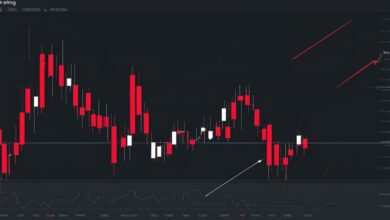Go For Gold: How To Trade Gold Options

Gold options have emerged as a popular financial instrument for investors looking to attain a position in gold without requiring substantial upfront capital. These options contracts are based on either physical gold or gold futures, providing individuals with the opportunity to participate in the gold market with flexibility and lower capital requirements.
Understanding gold options and how to trade them is essential for anyone interested in exploring this investment avenue. In this article, we will delve into the mechanics of gold options, discuss different strategies, and provide valuable tips for trading gold options effectively.
Key Takeaways:
- Gold options allow investors to gain exposure to the gold market without substantial upfront capital.
- They are based on either physical gold or gold futures.
- Gold options provide potential profit opportunities even when gold prices rise, fall, or remain stagnant.
- Trading gold options involves risks, and it’s important to understand the mechanics and strategies.
- Accessing gold options markets requires a margin brokerage account with access to options trading platforms.
Benefits of Trading Gold Options
Trading gold options offers several advantages for investors looking to diversify their portfolios and take advantage of opportunities in the gold market. Here are some key benefits of investing in gold options:
- Potential for Profit: Gold options provide investors with the flexibility to profit from both rising and falling gold prices. With call options, investors can benefit from price increases, while put options allow them to profit from price declines. This versatility gives traders the potential to generate returns in various market conditions.
- Lower Capital Requirements: Compared to buying physical gold or gold futures contracts, trading gold options requires less upfront capital. Options contracts are leveraged financial instruments, allowing investors to control a larger amount of gold with a smaller investment. This lower capital requirement makes gold options more accessible to a wider range of investors.
- Risk Management: Gold options provide an effective tool for managing risk in the volatile gold market. By using options strategies such as buying protective puts or selling covered calls, investors can protect their positions and mitigate potential losses. These strategies can help traders navigate market fluctuations and ensure their portfolios are well-protected.
While gold options offer several advantages, it’s important to understand the risks associated with investing in this financial instrument:
- Price Volatility: Like any investment, gold options are subject to price volatility. Fluctuating gold prices can impact the value of options contracts, potentially leading to losses if market movements are unfavorable. It’s essential for investors to carefully monitor market conditions and make informed decisions to mitigate risks.
- Time Decay: Options contracts have an expiration date, and the value of the option diminishes over time. This time decay can erode the value of the option, especially if the price of gold doesn’t move in the desired direction. Traders need to consider the time factor when trading gold options and choose expiration dates that align with their market expectations.
- Market Risk: The gold market is influenced by various factors, including economic conditions, geopolitical events, and interest rates. These market risks can significantly impact the price of gold and, in turn, the value of gold options. It’s crucial for traders to stay informed about global events and trends that can affect the gold market.
By weighing the benefits and risks involved in trading gold options, investors can make informed decisions and effectively capitalize on opportunities in the gold market.

Gold Options vs. Other Investment Options
When it comes to investing in gold, there are various options available to investors. Gold options, gold futures, physical gold, ETFs, and stocks each offer unique advantages and disadvantages. Understanding the differences between these investment options can help investors make informed decisions that align with their investment goals and risk tolerance.
Gold Options vs. Gold Futures
Gold options and gold futures are both derivatives that allow investors to gain exposure to gold prices. However, there are key differences between the two. Gold options provide the right, but not the obligation, to buy or sell gold at a specific price before the contract expires. On the other hand, gold futures contracts require the buyer or seller to fulfill the contract at the agreed-upon price and date. Gold options offer more flexibility as investors have the choice to exercise the options or let them expire.
Gold Options vs. Physical Gold
Investing in physical gold involves purchasing and storing gold bars or coins. While physical gold provides tangible ownership, it also comes with costs and logistical challenges, such as storage and insurance. Gold options, on the other hand, offer a more accessible and cost-effective way to gain exposure to gold prices. Investors can participate in the gold market without the need for physical possession or storage of the precious metal.
Gold Options vs. ETFs and Stocks
Exchange-traded funds (ETFs) and stocks provide exposure to the gold industry through company shares. While gold ETFs offer diversification across multiple gold-related assets, such as mining companies and physical gold, gold options provide direct exposure to gold price movements. Stocks of gold mining companies may also be influenced by factors beyond gold prices, such as company-specific risks. Gold options, in comparison, focus solely on gold price movements.
| Gold Options | Gold Futures | Physical Gold | ETFs | Stocks | |
|---|---|---|---|---|---|
| Ownership | No ownership of physical gold | No ownership of physical gold | Tangible ownership of physical gold | No ownership of physical gold | Ownership of company shares |
| Liquidity | High | High | Dependent on market conditions | High | Dependent on market conditions and individual stock liquidity |
| Flexibility | Ability to choose exercise or expiration | Obligation to fulfill contract | Owning physical gold | Ability to buy or sell shares | Ability to buy or sell shares |
| Capital Requirements | Lower upfront capital required | Higher margin requirements | Higher upfront capital required | Vary depending on ETF price | Vary depending on stock price |
It’s important for investors to carefully consider their investment objectives, risk tolerance, and market conditions when choosing between gold options, gold futures, physical gold, ETFs, and stocks. Each investment option offers different benefits and considerations, and the choice ultimately depends on individual preferences and goals.

How to Trade Gold Options
Trading gold options can be a lucrative venture for investors looking to diversify their portfolios. Here, we will guide you through the process of trading gold options, from selecting the right trading platform to implementing effective option trading strategies.
Choosing the Right Trading Platform
When it comes to trading gold options, it is essential to find a reliable and user-friendly trading platform. Some popular platforms that offer access to gold options markets include Interactive Brokers and TD Ameritrade. These platforms provide comprehensive options trading services, allowing you to buy and sell gold options with ease.
Implementing Option Trading Strategies
Once you have selected a trading platform, it’s time to develop effective option trading strategies. When expecting gold prices to rise, buying call options can be a profitable approach. Conversely, if you anticipate a decline in gold prices, buying put options can help protect your investment from potential losses. Additionally, you can sell gold options to lock in profits or minimize losses, depending on your market outlook.
It’s crucial to research and understand different option trading strategies to make informed decisions. Whether you are a beginner or an experienced trader, having a clear plan in place will help you navigate the gold options market effectively.
| Step | Action |
|---|---|
| 1 | Choose a reputable trading platform that offers access to gold options markets. |
| 2 | Research and understand various option trading strategies, such as buying call options, buying put options, and selling options. |
| 3 | Implement your chosen trading strategy based on your market outlook. |
| 4 | Monitor the market closely and adjust your positions as necessary. |
By following these steps and staying informed about market trends, you can successfully trade gold options and potentially profit from fluctuations in gold prices.

In summary, gold options prices are influenced by various factors, including gold price volatility, market conditions, economic factors, geopolitical events, interest rates, and the value of the US dollar. Traders and investors should closely monitor these factors and their potential impact on the gold market to make informed trading decisions.
Risks Associated with Gold Options Trading
When engaging in gold options trading, it is important to understand and consider the various risks involved. Like any investment, trading gold options carries potential losses and exposes traders to market risk.
Price Volatility: Gold options prices can be highly volatile, which means that the value of the options can fluctuate significantly. This volatility can lead to potential losses if the market moves unfavorably.
Potential Losses: There is a risk of options expiring worthless, resulting in the loss of the premium paid for the option. It is important for traders to carefully monitor their positions and manage risk accordingly.
Market Risk: The price of gold options is influenced by various market conditions, including supply and demand dynamics, economic factors, geopolitical events, and the value of the US dollar. Unexpected events or changes in market conditions can increase the level of risk in gold options trading.
| Risks | Description |
|---|---|
| Price Volatility | Gold options prices can be highly volatile, leading to potential losses. |
| Potential Losses | There is a risk of options expiring worthless, resulting in the loss of the premium paid. |
| Market Risk | The price of gold options is influenced by various market conditions. |
Traders should carefully assess their risk tolerance and develop a trading plan that incorporates proper risk management strategies. This may include setting stop-loss orders, diversifying their portfolio, and staying informed about market trends and news that may impact gold prices.
Common Strategies for Gold Options Trading
When it comes to trading gold options, there are several common strategies that traders can employ to maximize their potential profits. These strategies vary based on market conditions and the trader’s outlook on the price of gold. Here, we will discuss some of the most popular strategies used in gold options trading.
Option Buying Strategies
One of the strategies employed by traders is buying call options, especially when they anticipate a rise in the price of gold. Call options give the holder the right to buy gold at a predetermined price before the option expires. This strategy allows traders to profit from the increase in gold prices without actually owning the physical gold. Another option buying strategy is purchasing put options, which gives the holder the right to sell gold at a specific price. Traders use this strategy when they believe the price of gold will decrease.
Option Selling Strategies
Option selling strategies involve writing options contracts to collect the premiums. One popular option selling strategy is the covered call. In this strategy, traders sell call options on gold they already own. If the price of gold remains below the strike price of the options, the trader keeps the premium as profit. However, if the price of gold surpasses the strike price, the trader must sell their gold but still keeps the premium as a consolation. This strategy allows traders to generate income from their gold holdings while potentially benefiting from a limited upside.
Trading Sideways Market
When the market is expected to trade in a sideways range, traders can use strategies such as the straddle or strangle. These strategies involve simultaneously buying both call and put options with the same expiration date and strike price, but different premiums. By using these strategies, traders can profit from the low volatility and potential price movements in either direction. The strangle strategy involves buying out-of-the-money options with different strike prices, while the straddle strategy involves buying at-the-money options.
It is crucial for traders to thoroughly understand each strategy and its associated risks before implementing them in gold options trading. These strategies can be powerful tools when used correctly, allowing traders to take advantage of various market conditions and potentially increase their returns. However, it is always important to remember that trading involves risks, and proper risk management should be practiced at all times.
Understanding Gold Options Market
When it comes to trading gold options, understanding the gold options market is crucial for success. The gold options market refers to the platform where gold options are bought and sold. It operates on the Chicago Mercantile Exchange (CME), specifically the COMEX unit. This market allows investors to speculate on the price movements of gold and potentially profit from them.
One important aspect of the gold options market is trading volume. Trading volume refers to the number of options contracts that are being traded within a specific period. A higher trading volume indicates more market activity and liquidity. Market liquidity is essential because it ensures that there are enough buyers and sellers for investors to enter and exit positions without significant price slippage.
| Key Points | Gold Options Market |
|---|---|
| Primary Market | CME COMEX |
| Trading Volume | Indicates market activity and liquidity |
| Market Liquidity | Ensures ease of entering and exiting positions |
Market liquidity can vary based on market conditions and investor sentiment. During periods of high volatility or economic uncertainty, the gold options market may experience increased trading volume and heightened liquidity. Conversely, during periods of stability, the market may see lower trading volume and decreased liquidity.
As traders and investors, it is essential to consider the gold options market’s trading volume and liquidity when making trading decisions. By analyzing market trends and understanding the dynamics of the market, traders can make informed choices and identify potential opportunities in the gold options market.

Table: Key Terms in Gold Options Trading
| Term | Description |
|---|---|
| Option pricing | The process of determining the value of gold options based on various factors |
| Buying options | The right to purchase gold at a specified price before the contract expires |
| Selling options | Granting someone else the right to buy gold from the investor at a predetermined price |
| Exercise of options | The decision made by option holders to buy or sell gold at the specified price or let the option expire |
By understanding the mechanics of gold options trading, investors can make informed decisions and navigate the market effectively. It is crucial to grasp the intricacies of option pricing, buying and selling options, and the exercise of options to maximize potential profits and minimize risks.
Conclusion
In conclusion, gold options provide investors with a flexible and capital-efficient way to participate in the gold market. With the ability to profit from rising, falling, or stagnant gold prices, these options offer a range of opportunities for traders. However, it is crucial to understand the risks associated with gold options trading and to carefully consider market conditions and events that can impact prices.
By implementing effective strategies and managing risk appropriately, traders can navigate the gold options market with confidence. It is important to thoroughly grasp the mechanics of gold options, including option pricing and the exercise process, to make well-informed trading decisions.
In summary, gold options offer an alternative avenue for investors to gain exposure to the gold market, even with limited upfront capital. By considering the factors discussed in this article and adopting a disciplined approach, traders can harness the potential benefits of gold options trading while mitigating the inherent risks.
FAQ
What are gold options?
Gold options are financial instruments that allow investors to attain a position in gold without the need for substantial up-front capital. These options contracts utilize either physical gold or gold futures as their underlying asset.
Where are gold options listed?
Gold options are listed on the Chicago Mercantile Exchange (CME) COMEX and are cleared through the CME. However, not all brokers may have access to these markets.
How can I trade gold options?
To trade gold options, you need a margin brokerage account that offers access to options markets. Various trading platforms, such as Interactive Brokers and TD Ameritrade, offer options trading services.
What are the benefits of trading gold options?
Trading gold options allows for the potential to profit whether gold prices rise, fall, or remain stagnant. It also offers a shorter-term and less capital-intensive way to invest in gold compared to buying physical gold or gold futures.
What are the risks associated with investing in gold options?
Risks associated with investing in gold options include the potential loss of the premium paid for the option if the price of gold does not move favorably. The price of gold options can also be volatile, leading to potential losses if the market moves unfavorably.
How do gold options differ from other investment options?
Gold options provide the right, but not the obligation, to buy or sell gold at a specific price before the contract expires. Gold futures contracts have an obligation to transact at the agreed-upon price. Gold options also offer more flexibility and lower upfront capital requirements compared to physical gold. ETFs and stocks are different investment vehicles that provide exposure to the gold industry through company shares.
What are the trading specifications of gold options?
Each gold options contract controls 100 ounces of gold. The options contract size and strike prices are standardized, with several strike prices offered in $5 increments above or below the current gold price. Gold options have a range of expiry times to choose from, ranging from short-term to long-term.
What factors can impact the price of gold options?
Several factors can impact the price of gold options, including market conditions, economic factors, geopolitical events, interest rates, and the value of the US dollar. Traders and investors closely monitor these factors to make informed decisions when trading gold options.
What are the common strategies for trading gold options?
Common strategies for trading gold options include buying call options if expecting gold prices to rise and buying put options if expecting gold prices to fall. Traders may also employ strategies such as writing covered calls or selling straddles to profit from low volatility or sideways market conditions.
How do I access the gold options market?
The gold options market operates on the CME, specifically the COMEX unit. Investors need a margin brokerage account that provides access to options markets. Not all brokers may offer direct access to gold options markets, so it’s important to check with your broker.
What are the mechanics of gold options trading?
Option pricing for gold options is influenced by factors such as the current price of gold, time to expiration, volatility, and interest rates. Traders can buy or sell options based on their market outlook. The exercise of options depends on the holder’s decision to exercise their right to buy or sell gold at the specified price.







